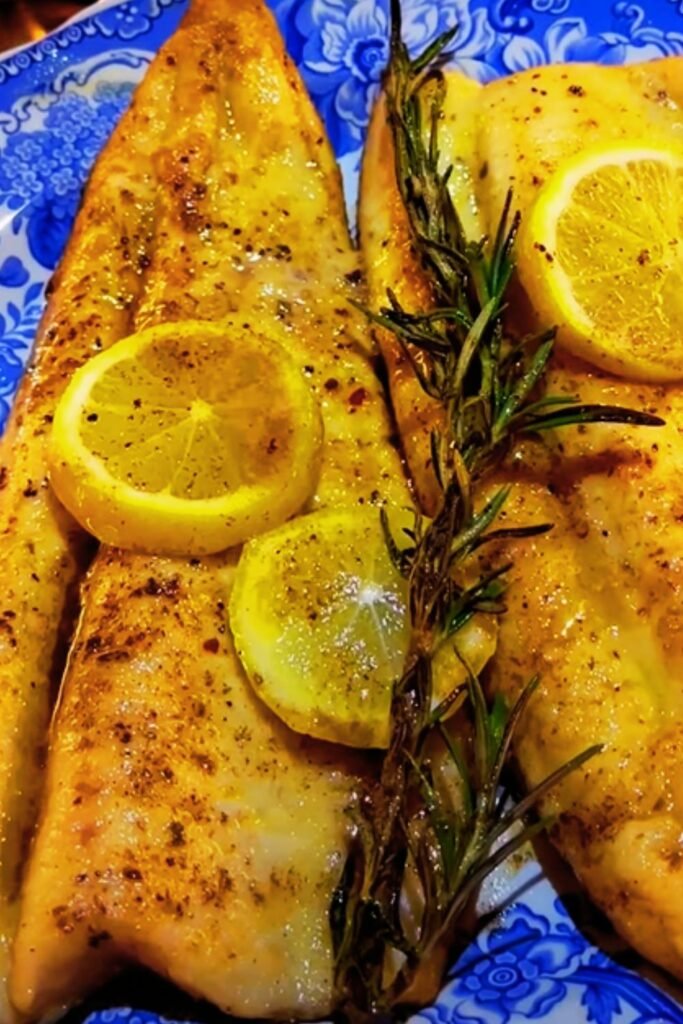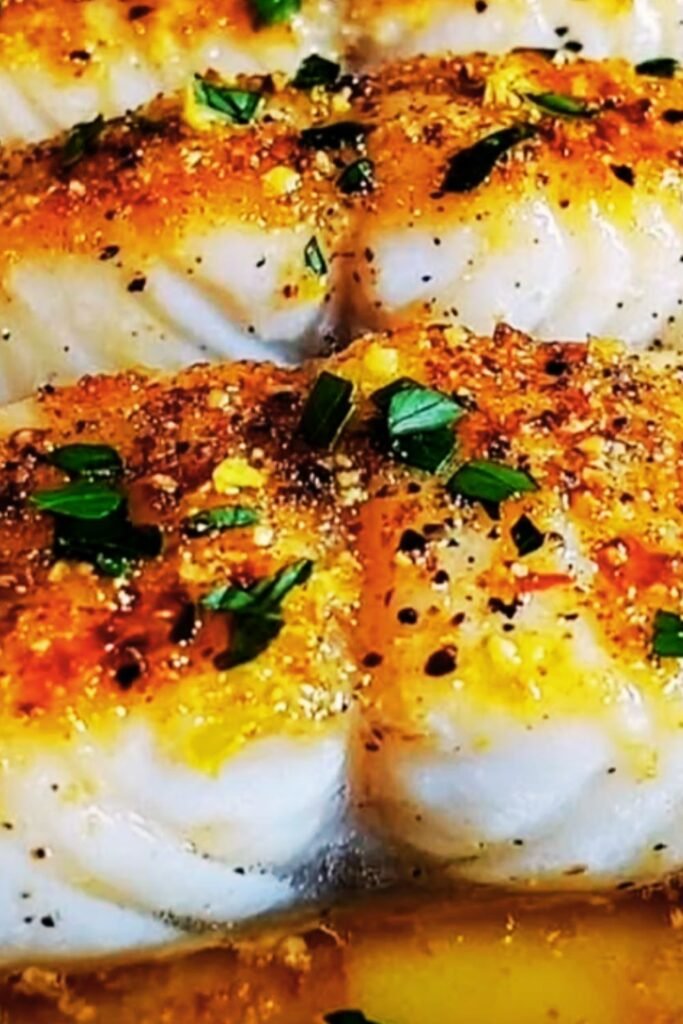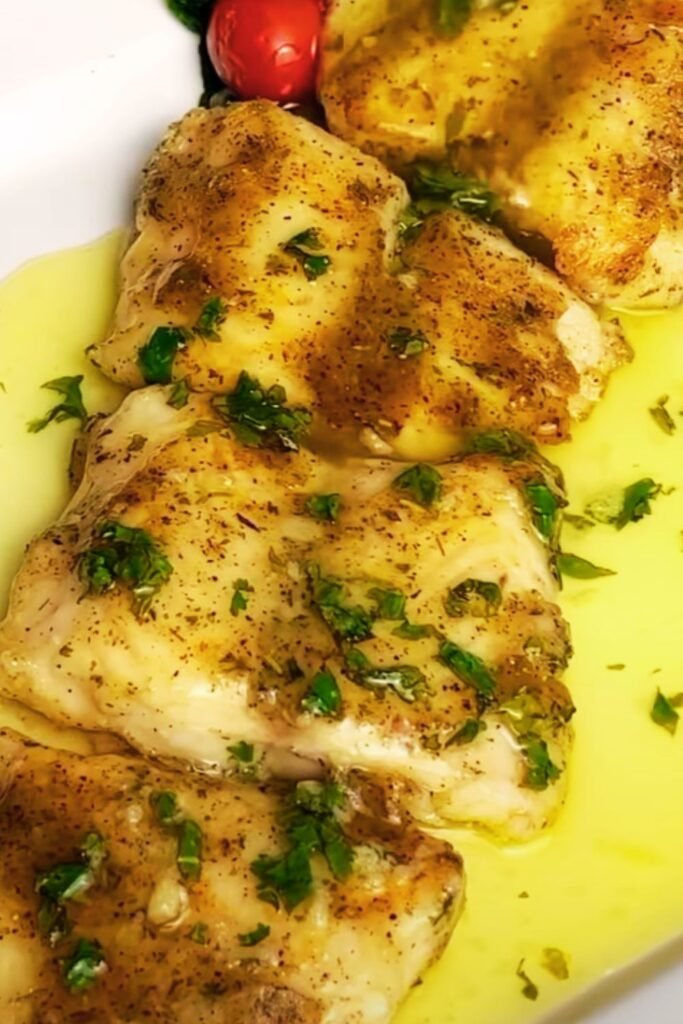There’s something magical about flounder that makes me absolutely passionate about cooking with this delicate fish. When I first discovered how to prepare buttery lemon pepper flounder, it completely changed my perspective on weeknight dinners. The tender, flaky texture combined with bright citrus notes and the gentle heat of freshly cracked pepper creates a symphony of flavors that never fails to impress my family and guests.
Flounder represents one of those underrated gems in the seafood world. While salmon and tuna often steal the spotlight, I’ve found that flounder offers incredible versatility and a mild flavor profile that welcomes bold seasonings without being overwhelmed. My buttery lemon pepper preparation has become my go-to method for showcasing this wonderful fish, and I’m excited to share every detail with you.
Understanding Flounder: The Foundation of Great Cooking
Flounder is a flatfish belonging to the family Pleuronectidae, characterized by its unique body structure where both eyes are located on one side of its head. This adaptation allows flounder to lie flat on the ocean floor, making it an excellent bottom-dwelling predator.
Texture Profile refers to the delicate, fine-flaked structure of flounder meat, which separates easily when cooked properly and provides a tender, almost buttery mouthfeel.
Flavor Base describes flounder’s mild, slightly sweet taste that serves as an excellent canvas for various seasonings and preparation methods without competing with added flavors.
The key to working with flounder lies in understanding its delicate nature. Unlike meatier fish such as swordfish or tuna, flounder requires gentle handling and precise cooking techniques. I’ve learned through years of experience that respecting the fish’s natural characteristics leads to consistently exceptional results.
When selecting flounder, I always look for fillets that appear translucent with a slight pinkish hue. Fresh flounder should smell like clean ocean water, never fishy or ammonia-like. The flesh should feel firm to the touch and spring back when pressed gently. These quality indicators ensure that my buttery lemon pepper preparation will shine.
The Science Behind Perfect Lemon Pepper Seasoning
Creating the ideal lemon pepper blend involves more than simply combining two ingredients. I’ve discovered that the ratio, preparation method, and timing of application all contribute significantly to the final flavor profile.
Citrus Oils are the volatile compounds found in lemon zest that provide intense, bright flavor and aromatic properties essential for proper seasoning penetration.
Piperine is the alkaloid compound in black pepper responsible for its pungent heat and ability to enhance other flavors through chemical interaction.
Maillard Reaction occurs when proteins and sugars in the fish interact with heat, creating complex flavors and the desirable golden-brown color on the surface.
My approach to lemon pepper seasoning focuses on maximizing these natural compounds. I use freshly grated lemon zest rather than dried, as the essential oils remain more potent and provide superior flavor impact. Similarly, I crack whole peppercorns just before use to preserve the volatile oils that give pepper its distinctive bite.
The timing of seasoning application matters tremendously. I apply my lemon pepper mixture to the flounder approximately fifteen minutes before cooking, allowing the salt in the blend to begin drawing out moisture while the acids start their tenderizing work. This brief curing period enhances both flavor penetration and texture development.
Essential Ingredients and Quality Considerations

| Ingredient | Quantity | Quality Markers | Purpose | Substitutions |
|---|---|---|---|---|
| Flounder Fillets | 4 pieces (6 oz each) | Translucent, firm, ocean-fresh smell | Main protein | Sole, Halibut, Cod |
| Fresh Lemons | 3 large | Heavy, bright yellow, fragrant | Zest and juice | Meyer lemons, Limes |
| Black Peppercorns | 2 tablespoons | Whole, aromatic, no dust | Heat and flavor | White pepper, Mixed peppercorns |
| Unsalted Butter | 6 tablespoons | European-style preferred | Richness and cooking medium | Ghee, Olive oil |
| Sea Salt | 1 teaspoon | Fine crystal, pure white | Flavor enhancement | Kosher salt, Table salt |
| Fresh Thyme | 2 sprigs | Bright green, fragrant | Herbal complexity | Oregano, Rosemary |
| Garlic | 2 cloves | Firm, papery skin intact | Aromatic base | Garlic powder, Shallots |
| White Wine | 1/4 cup | Dry, crisp variety | Deglazing and moisture | Chicken broth, Lemon juice |
The quality of ingredients directly impacts the final dish. I source my flounder from reputable fishmongers who can tell me exactly when the fish arrived. For lemons, I prefer organic varieties when possible, as I use the zest extensively and want to avoid any chemical residues.
Butter selection makes a noticeable difference in this preparation. European-style butter contains less water and more fat, resulting in better browning and richer flavor development. The higher fat content also helps prevent the delicate fish from sticking to the pan during cooking.
Step-by-Step Preparation Method

The success of buttery lemon pepper flounder depends heavily on proper technique and timing. I’ve refined this method through countless preparations, and each step serves a specific purpose in creating the perfect final dish.
Preparation Phase
I begin by removing the flounder from refrigeration thirty minutes before cooking, allowing it to reach room temperature for even cooking. During this time, I prepare my lemon pepper seasoning by zesting three lemons using a microplane grater, being careful to avoid the bitter white pith beneath the colorful outer layer.
Next, I crack the peppercorns using a mortar and pestle, aiming for pieces roughly half the size of the original corns. This size provides the perfect balance between flavor release and texture. Too fine, and the pepper becomes overwhelming; too coarse, and it doesn’t integrate properly with the other flavors.
I combine the lemon zest, cracked pepper, and sea salt in a small bowl, mixing thoroughly to distribute the ingredients evenly. This dry seasoning blend can be prepared up to one day in advance and stored in the refrigerator, though I prefer using it fresh for maximum potency.
Seasoning Application
Pat the flounder fillets completely dry using paper towels, as any surface moisture will prevent proper seasoning adhesion and interfere with browning. I apply the lemon pepper mixture generously to both sides of each fillet, pressing gently to help the seasoning adhere to the fish.
The seasoned fillets rest on a wire rack for fifteen minutes, allowing the salt to begin its work while the flavors meld together. This brief curing period also helps the surface moisture evaporate, contributing to better searing later.
Cooking Process
I heat a large stainless steel or cast-iron skillet over medium-high heat, adding two tablespoons of butter once the pan is properly preheated. The butter should foam immediately upon contact, indicating the correct temperature for cooking the fish.
Carefully place the seasoned flounder fillets in the hot butter, ensuring not to overcrowd the pan. Overcrowding leads to steaming rather than searing, preventing the development of the golden crust that makes this dish so appealing.
Cook the first side for three to four minutes without moving the fillets, allowing the Maillard reaction to create a beautiful golden-brown surface. I resist the temptation to peek or adjust the fish during this crucial browning period.
The Flip and Finish
Using a thin spatula, I carefully flip each fillet, adding the remaining butter to the pan along with minced garlic and fresh thyme. The second side requires only two to three minutes of cooking time, as flounder cooks quickly and can become tough if overdone.
During the final cooking phase, I add white wine to the pan, creating steam that helps finish cooking the fish while adding another layer of flavor. The wine also helps deglaze any browned bits from the bottom of the pan, incorporating those flavors into the final sauce.
I finish by squeezing fresh lemon juice over the cooked fillets and spooning the pan butter over the top, creating a rich, flavorful sauce that complements the delicate fish perfectly.
Nutritional Profile and Health Benefits
| Nutrient | Per Serving | Daily Value % | Health Benefits |
|---|---|---|---|
| Protein | 32g | 64% | Muscle maintenance, satiety |
| Omega-3 Fatty Acids | 0.8g | 50% | Heart health, brain function |
| Vitamin B12 | 2.4mcg | 100% | Nerve function, energy metabolism |
| Selenium | 28mcg | 51% | Antioxidant protection |
| Phosphorus | 280mg | 28% | Bone health, cellular function |
| Calories | 285 | 14% | Energy provision |
| Total Fat | 16g | 25% | Hormone production, vitamin absorption |
| Saturated Fat | 8g | 40% | From butter content |
Flounder offers exceptional nutritional value while remaining relatively low in calories. The high protein content makes it an excellent choice for those focusing on muscle maintenance or weight management. I particularly appreciate that flounder provides complete proteins containing all essential amino acids in proper proportions.
The omega-3 fatty acids in flounder, while not as concentrated as in salmon or mackerel, still contribute meaningfully to cardiovascular health and cognitive function. These beneficial fats work synergistically with the vitamin B12 content to support nervous system health and energy metabolism.
Advanced Techniques and Variations

Through years of preparing this dish, I’ve developed several advanced techniques that elevate the basic preparation to restaurant-quality results.
Compound Butter Enhancement involves incorporating herbs, citrus zest, and seasonings directly into softened butter, creating a more complex flavor profile that melts over the hot fish.
Pan Temperature Control requires understanding the visual and auditory cues that indicate proper heating levels throughout the cooking process.
Sauce Development utilizes the fond (browned bits) left in the pan to create rich, flavorful sauces that complement rather than mask the delicate fish.
Herb-Crusted Variation
For special occasions, I sometimes create a more elaborate version using fresh herbs and breadcrumbs. I combine panko breadcrumbs with chopped parsley, thyme, and additional lemon zest, pressing this mixture onto the seasoned fillets before cooking. This technique requires slightly lower heat to prevent the coating from burning while ensuring the fish cooks through completely.
Mediterranean Influence
My Mediterranean-inspired variation incorporates capers, sun-dried tomatoes, and fresh basil into the pan during the final cooking phase. These ingredients add complexity and visual appeal while maintaining the dish’s elegant simplicity.
Asian Fusion Approach
Sometimes I adapt the basic technique using ginger instead of garlic, rice wine instead of white wine, and finishing with sesame oil and cilantro. This variation demonstrates the versatility of the cooking method while creating an entirely different flavor experience.
Serving Suggestions and Pairings
The delicate nature of buttery lemon pepper flounder makes it versatile enough to pair with numerous side dishes and accompaniments. I’ve found that the key lies in selecting components that complement rather than compete with the fish’s subtle flavors.
Vegetable Pairings
Roasted asparagus with almonds provides textural contrast and earns points for its complementary flavors. The slight bitterness of asparagus balances the richness of the butter while the almonds add satisfying crunch.
Garlic mashed potatoes create a comforting, classic combination that appeals to all age groups. The creamy texture absorbs the pan sauce beautifully, ensuring no flavor goes to waste.
Steamed broccoli with lemon brightens the plate while providing essential nutrients and fiber. I often finish the broccoli with a touch of the same lemon pepper seasoning used on the fish for flavor harmony.
Starch Options
Wild rice pilaf offers nutty flavors and interesting texture that doesn’t overwhelm the delicate fish. The rice absorbs the pan juices while contributing its own subtle taste to the overall meal.
Herb-roasted fingerling potatoes provide heartiness and visual appeal. I often cook them with similar herbs used in the fish preparation, creating a cohesive flavor profile across the entire plate.
Quinoa salad with vegetables adds protein and creates a more health-conscious presentation. The neutral grain flavor allows the fish to remain the star while contributing important nutrients.
Storage and Leftover Applications
Proper storage of cooked flounder requires attention to food safety principles while maintaining quality for future use. I cool leftover fish quickly and refrigerate within two hours of cooking to prevent bacterial growth.
Cooked flounder keeps in the refrigerator for up to three days when stored in airtight containers. I separate the fish from any pan sauce to prevent the delicate flesh from becoming soggy during storage.
Leftover Transformation Ideas
Cold flaked flounder makes excellent fish salad when combined with mayonnaise, celery, and fresh herbs. This preparation works wonderfully in sandwiches or served over greens for a light lunch.
Leftover flounder can be gently reheated and flaked into scrambled eggs for a protein-rich breakfast. The lemon pepper flavors complement eggs beautifully, creating an elegant morning meal.
Fish cakes represent another excellent use for leftover flounder. I combine flaked fish with mashed potatoes, egg, and seasonings, forming patties that can be pan-fried until golden and crispy.
Troubleshooting Common Issues
Through years of preparing this dish, I’ve encountered and solved numerous common problems that home cooks face when working with delicate fish.
Sticking Problems
Fish sticking to the pan usually indicates insufficient preheating or inadequate fat content. I ensure my pan reaches proper temperature before adding butter, and I use enough fat to create a thin layer across the entire cooking surface.
Overcooking Prevention
Flounder’s delicate nature makes it susceptible to overcooking, which results in tough, dry texture. I remove the fish from heat as soon as it flakes easily with a fork, as residual heat will continue cooking the protein even after removal from the stove.
Seasoning Balance
Achieving proper seasoning balance requires tasting and adjusting throughout the cooking process. I start with less seasoning than I think I need, as it’s easier to add more than to correct over-seasoning.
Seasonal Adaptations and Menu Planning
The versatility of buttery lemon pepper flounder makes it suitable for year-round preparation, though I adapt the accompanying elements based on seasonal availability and preferences.
Spring Presentations
During spring months, I emphasize fresh peas, asparagus, and early herbs in my accompaniments. The bright, clean flavors complement the season’s renewal theme while celebrating fresh, local ingredients.
Summer Variations
Summer preparations often include fresh corn, tomatoes, and basil, creating lighter, more refreshing meals appropriate for warmer weather. Cold preparation methods also work well during hot months.
Fall and Winter Adaptations
Cooler months call for heartier accompaniments such as roasted root vegetables, wild rice, and more substantial sauces. These elements provide comfort and warmth while maintaining the dish’s elegant character.
Q&A Section
Q: How can I tell when flounder is perfectly cooked without overcooking it?
The best indicator is visual and textural. Properly cooked flounder will be opaque throughout and flake easily when tested with a fork at the thickest part. The internal temperature should reach 145°F (63°C), but I prefer using the flake test since it’s more reliable for delicate fish. The flesh should separate into clean, moist flakes without resistance.
Q: Can I prepare the lemon pepper seasoning in advance, and how long will it keep?
Absolutely! I often make larger batches of my lemon pepper blend and store it in an airtight container in the refrigerator. Fresh zest-based blends stay potent for up to one week, while dried versions last several months. However, I recommend using fresh zest when possible for maximum flavor impact.
Q: What’s the best way to prevent my flounder from falling apart during cooking?
The key is gentle handling and proper technique. Start with room-temperature fish, pat it completely dry, and avoid moving it too soon after placing it in the pan. Use a thin, flexible spatula for flipping, and support the entire fillet during the turn. If your fillets are particularly delicate, you can dust them lightly with flour before seasoning for added stability.
Q: How do I adjust this recipe for thicker or thinner flounder fillets?
Cooking time varies significantly with thickness. For thin fillets (under 1/2 inch), reduce cooking time to 2-3 minutes per side. Thicker pieces (over 1 inch) may need 5-6 minutes per side and might benefit from finishing in a 400°F oven for even cooking. Always rely on doneness tests rather than strict timing.
Q: Is it possible to make this dish without butter for dietary restrictions?
Yes, though the character changes significantly. High-quality olive oil works well, providing different but delicious results. Avocado oil offers neutral flavor and high smoke point. For dairy-free butter alternatives, I recommend brands specifically designed for cooking rather than spreading, as they perform better under heat.
Q: What wine pairs best with buttery lemon pepper flounder?
I prefer crisp white wines that complement rather than compete with the delicate fish. Sauvignon Blanc, Pinot Grigio, and unoaked Chardonnay all work beautifully. The acidity in these wines balances the butter richness while their clean flavors enhance the lemon pepper seasonings.
Q: Can I use frozen flounder for this recipe, and how should I thaw it?
Frozen flounder can work, though fresh is always preferable. Thaw frozen fillets slowly in the refrigerator overnight, never at room temperature or in warm water. Pat thawed fish extra dry, as freezing releases additional moisture. The texture may be slightly different, but proper technique still yields delicious results.
Q: How do I scale this recipe for a larger dinner party?
For larger groups, I cook the fish in batches to avoid overcrowding, keeping finished portions warm in a low oven (200°F). Alternatively, you can finish the seared fish in the oven, which allows you to cook more portions simultaneously. Plan about 6 ounces of fish per person for main course servings.